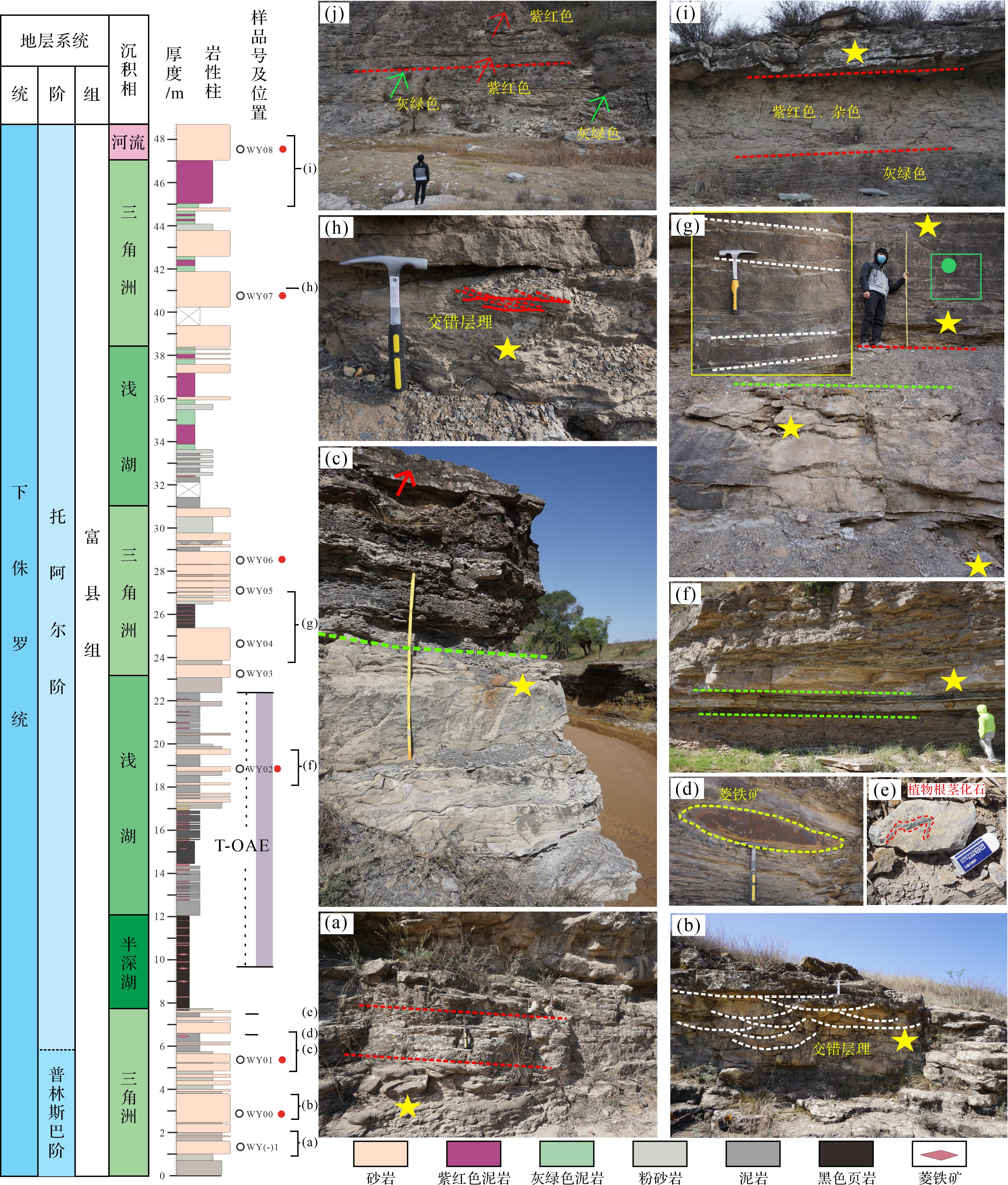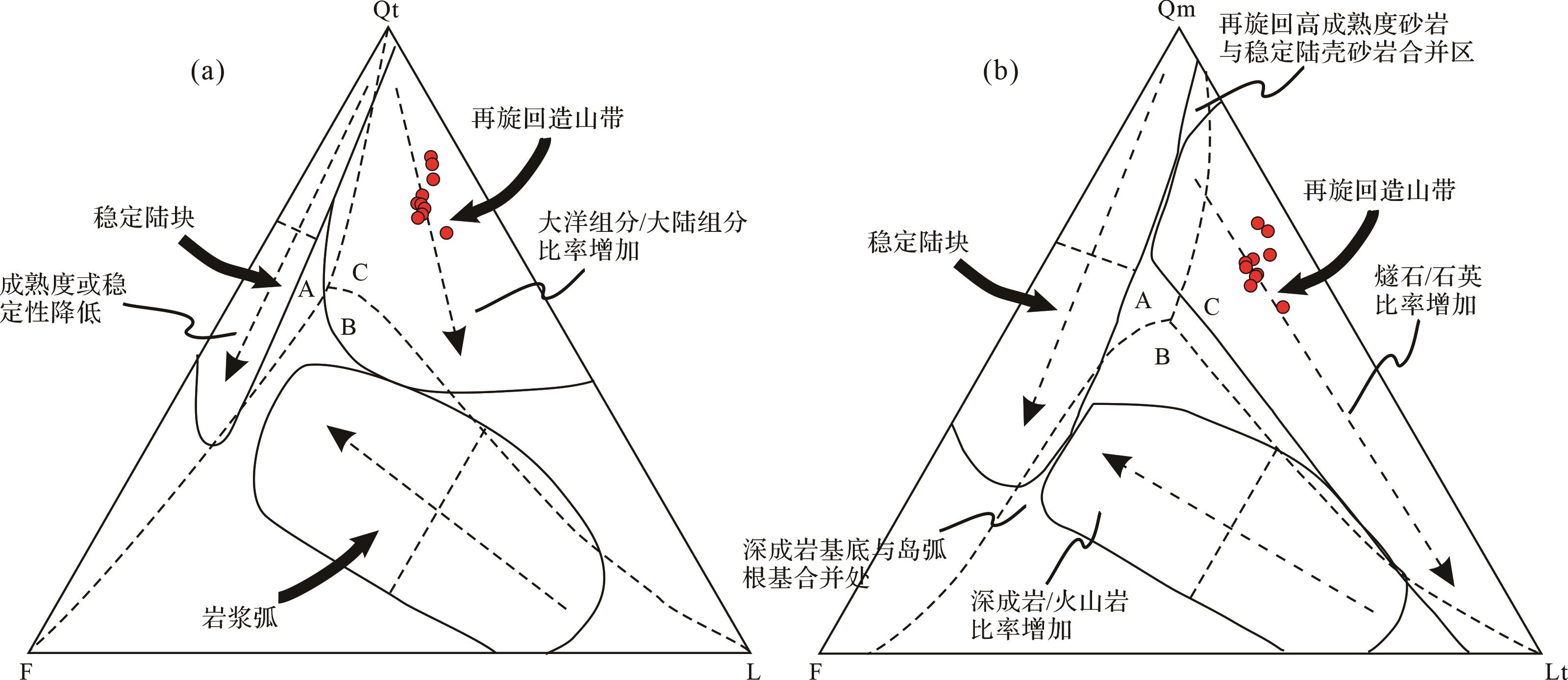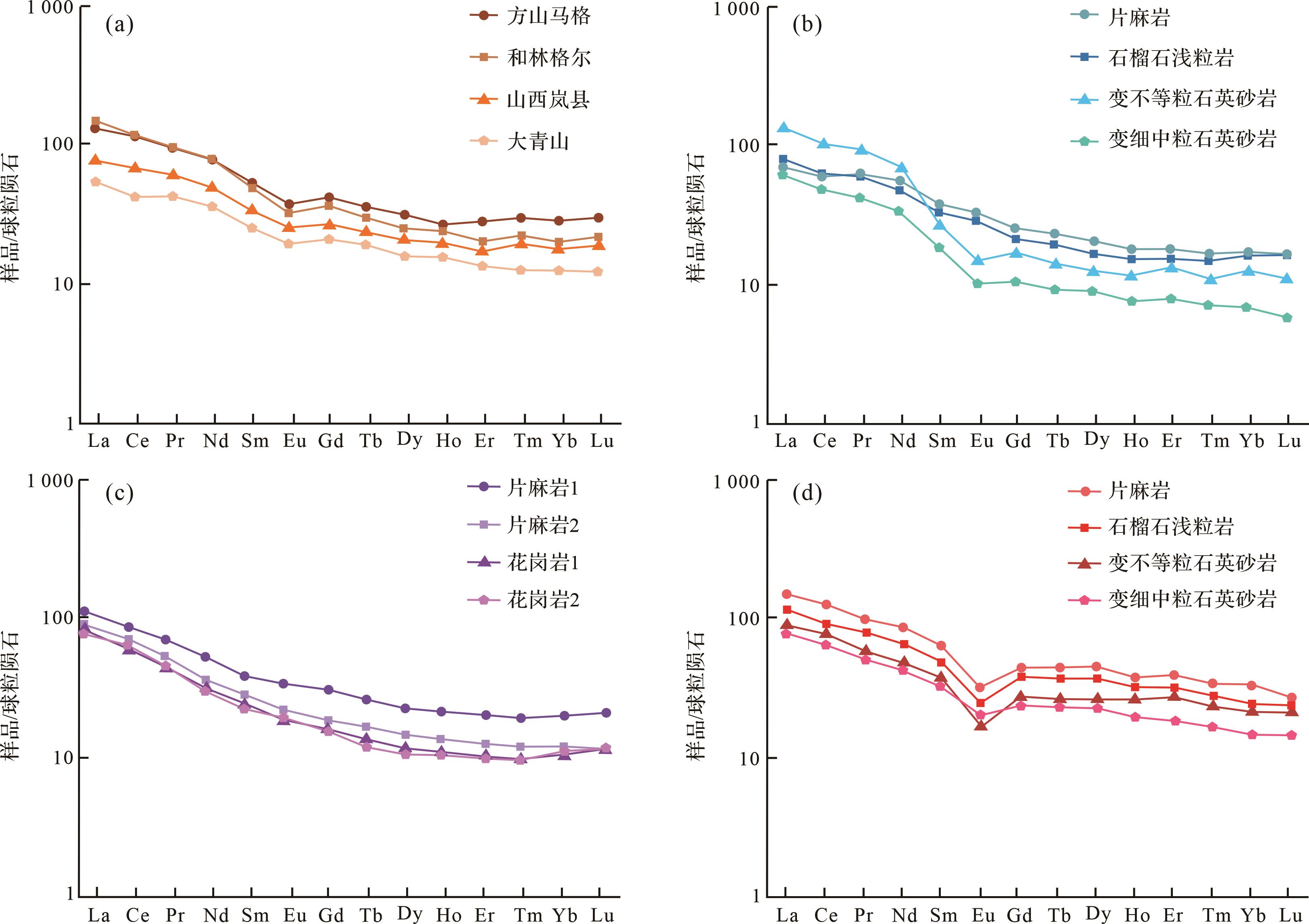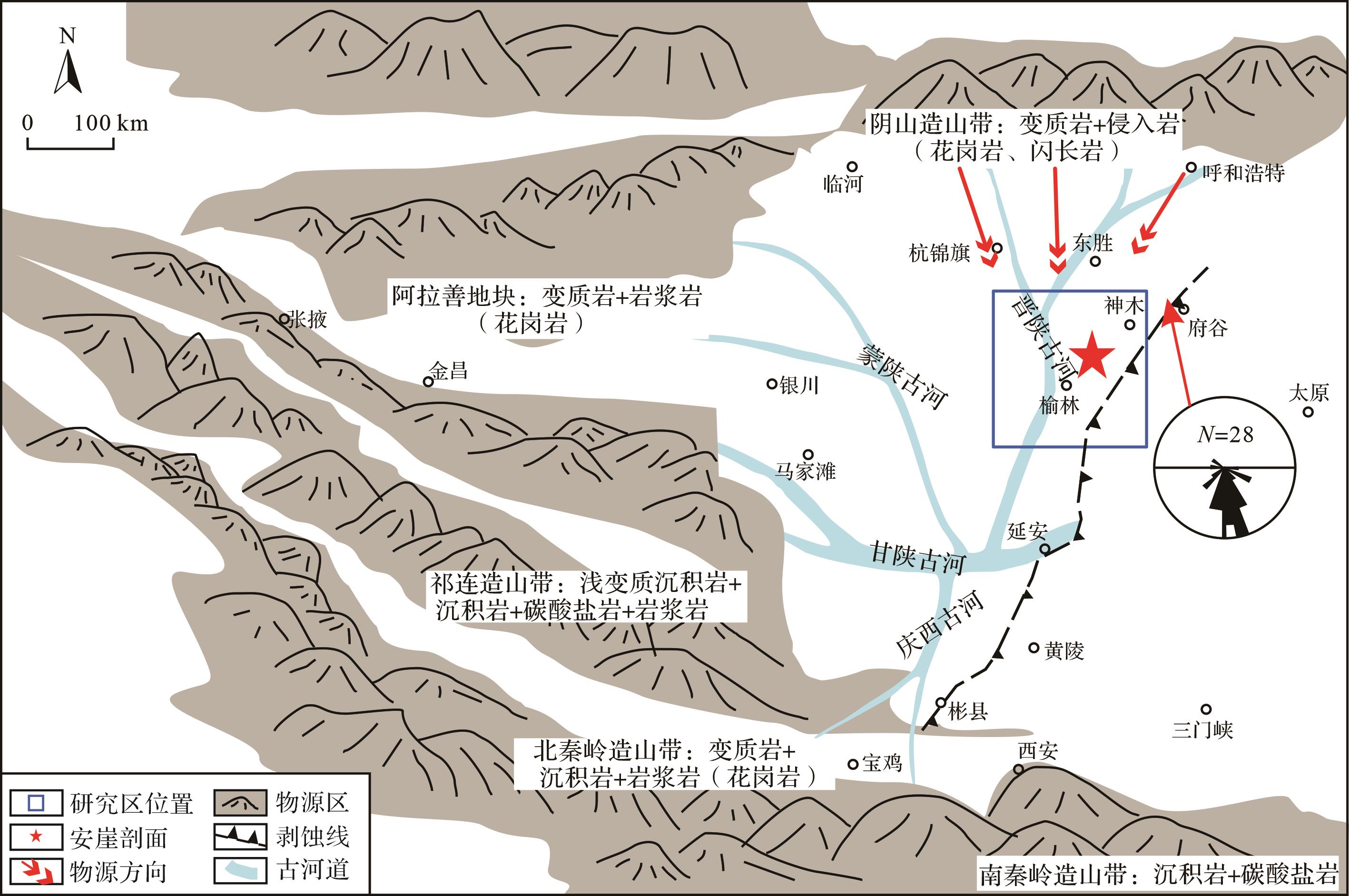HTML
-
20世纪80年代,元素地球化学方法开始被学者运用到地质构造复杂区域的研究工作中,当前已成为一种重要的分析手段[1⁃2]。一些元素(如Th、Sc、Co、Zr、Hf、Ga、Nb等)在母岩的风化、剥蚀、搬运、沉积及成岩过程中不易迁移,几乎被等量地搬运到碎屑沉积物中,因此可以用于物源示踪[2⁃3]。元素地球化学结合岩石学特征可以来判断沉积物母岩岩性[4⁃6]、风化程度[7⁃8]、沉积物搬运距离[9⁃10]及源区大地构造背景[4]等。
鄂尔多斯盆地是形成于中生代的内陆坳陷沉积盆地,也是我国最大的内陆含油气盆地和含煤盆地之一[11⁃12]。盆地内下侏罗统富县组地层沉积厚度较大、油藏丰富,是鄂尔多斯盆地中生界油气勘探开发的重要层系[11,13]。前人对于富县组的研究多聚焦于沉积环境等方面,认为鄂尔多斯盆地富县组主要发育浅湖相[14⁃15]、河流相[11,15]、冲积扇—河流相[11,16⁃17]及三角洲相[18]。而对源—汇系统这一研究方向及油气勘探领域的热点问题研究还较薄弱,只有少数学者对本次研究区邻区富县组的物源体系进行过研究,认为鄂尔多斯盆地中部(陕北斜坡中东部)富县组沉积时期物源主要来自北部、西北部及西部[19];盆地西南环县地区富县组时期物源方向为西南部[20];有学者以鄂尔多斯东北部考考乌素沟一带富县组底部的一套纯净石英砂岩为研究对象,通过沉积学、岩石学及元素地球化学等方法对富县组底部砂岩进行了物源分析,认为其物源为盆地内部隆起提供的富含石英质沉积岩,可能是延长组顶部长石砂岩风化蚀变形成的富含石英与高岭石的源区物质[21]。
此外,鄂尔多斯盆地位于华北克拉通的西部,处于中国西部活动带和东部稳定区域之间的结合部位,在全球构造中,介于古亚洲洋与原特提斯洋中的秦祁昆洋(商丹洋)之间,周缘被加里东造山带包围[22]。盆地北侧的古亚洲洋俯冲、西南缘和南缘秦—祁海槽及其派生的贺兰坳拉槽的扩张、俯冲、消减控制了鄂尔多斯盆地的演化[22]。因此,鄂尔多斯盆地是研究古亚洲构造域和古特提斯构造域的天然实验室,其盆—山演化一直是学者们关注的焦点。开展鄂尔多斯盆地物源研究,对探讨该地区的盆—山关系具有重要意义。然而,前人的研究主要在本次研究区(鄂尔多斯盆地东北部榆林地区)的周边地区,对于研究区富县组沉积时期的物源体系还缺乏研究。
通过岩石学和元素地球化学等研究手段,以鄂尔多斯盆地东北部榆林地区安崖剖面为研究对象,利用富县组砂岩的地球化学特征和岩石学特征分析了富县组沉积物的物质来源、源区构造背景,并结合周缘潜在源区的稀土元素数据对富县组时期的物源体系进行了探讨,以期厘定鄂尔多斯盆地东北部富县组沉积时期的物源体系,进而完善整个鄂尔多斯盆地早侏罗世物源体系,为华北克拉通盆—山演化提供相应的证据。
-
鄂尔多斯盆地位于中国大陆中部,是一个多旋回叠合型盆地,是我国仅次于塔里木盆地的第二大沉积盆地,也是我国形成历史最早、演化时间最长的盆地之一[23]。盆地东隔汾渭地堑与太行山相望,西翼以桌子山—贺兰山—六盘山为界,北翼以大青山—阴山造山带为界,南部以北祁连—秦岭造山带为界,横跨陕、甘、宁、蒙、晋,整体呈南北向矩形,面积约25×104 km2。广义的鄂尔多斯盆地包括周边河套、银川、渭河等新生代断陷盆地,总面积约36×104 km2[12,24⁃25]。
盆地在构造位置上位于华北克拉通的西部,其形成和演化与华北板块的演化存在密切联系。据前人研究,可以将鄂尔多斯盆地的构造演化分为太古—古元古代的盆地基底形成、中—新元古代的拗拉槽裂陷演化、早古生代的浅海台地演化、晚古生代的克拉通坳陷演化、中生代内陆盆地演化及新生代周缘断陷盆地演化等六个阶段[11⁃12,22,26]。根据现在盆地的构造形态,可划分为伊盟隆起、伊陕斜坡、渭北隆起、天环坳陷、晋西挠褶带及西缘冲断带等六个一级构造单元[15,27⁃30](图1a)。
盆地内沉积地层发育齐全,从元古界开始,仅缺失志留系、泥盆系及下石炭统[31]。其侏罗系为稳定型内陆盆地沉积,尽管部分地区由于基底隆起或顶部遭受冲刷(或剥蚀)变薄以及部分地层发育不全,但侏罗系在全盆地均有发育,尤其在盆地东南缘的延安、甘泉等地都有大面积的连续出露,沉积地层自下而上分为富县组(J1 f)、延安组(J1-2 y)、直罗组(J2 z)、安定组(J2a)、芬芳河组(J3 f)(图1b,c)。盆地内侏罗系与下伏的上三叠统呈区域微角度不整合接触关系,其上与下白垩统志丹群为角度不整合接触[32]。
-
安崖剖面(38°24'00" N;110°11'48" E)位于鄂尔多斯东北部(图1a),距离榆林市约40 km。安崖剖面厚度约49 m(图2)[15,33⁃34],剖面0~2.0 m岩性为中层砂岩与薄层灰白色粉砂岩互层(图2a)。2.0~4.0 m为中厚层灰色砂岩,发育交错层理(图2b)。4.0~7.8 m为灰绿色细砂岩、泥质粉砂岩和粉砂质泥岩互层(图2c),在粉砂质泥岩中可见菱铁矿结核(图2d)及植物根茎化石(图2e),砂岩分选性中等,磨圆度为次棱角状(图3c),是辫状河三角洲沉积环境的产物[15,35]。7.8 m之上有一套厚约4.2 m的黑色页岩,可见带状菱铁矿及透镜状菱铁矿,沉积环境为深湖或半深湖[15,35]。黑色页岩上方出露厚约2.3 m的深灰色粉砂质泥岩夹带状菱铁矿。14.5~17.0 m是一套厚约1.0 m的深灰色泥岩及厚约1.5 m的深灰色粉质泥岩,富含菱铁矿。17.0~23.0 m主要为杂色泥岩与薄层灰白色砂岩互层,夹杂有薄层白色粉砂岩,为浅湖相沉积[15]。23.0~31.0 m主要发育厚层灰白色、灰黄色砂岩,夹有薄层白色粉砂岩,发育水平层理,砂岩的分选和磨圆均较差,呈次棱角状(图3e~i)。25.3 m处发育一套厚约1.2 m的泥岩,为辫状河三角洲相沉积[15,35]。31.0~38.5 m主要发育杂色泥岩夹薄层砂岩,沉积环境为浅湖[15,35]。38.5~47.0 m主要发育紫色泥岩及中厚层灰白色砂岩,夹薄层灰绿色泥岩,其中砂岩分选、磨圆均较差,碎屑颗粒呈棱角状(图3j),为辫状河三角洲沉积[15]。47.0 m之后发育厚层灰白色砂岩,李昌昊等[15]认为是河流相沉积。前人根据孢粉组合、古地理及沉积环境认为早侏罗世早期是温暖湿润的气候环境,中晚期变成炎热干旱的气候环境[15,36]。

Figure 2. Outcrop characteristics of the Fuxian Formation sedimentary profile in the Anya section, northeastern Ordos Basin

Figure 3. Microscopic characteristics of sandstone from the Fuxian Formation in the Anya section, northeastern Ordos Basin
此外,在安崖剖面中下部黑色页岩和泥岩中(10.3~20.0 m,图2),记录了中生代著名的极热事件之一,即早侏罗世托阿尔期大洋缺氧事件(Toarcian Oceanic Anoxic Event,T-OAE)[33⁃34],这一事件一直是学界关注的焦点。T-OAE时期,由于古生物生产力提高或缺氧,富含有机质的沉积物在全球陆架区广泛沉积[37],还伴随着大气中CO2浓度升高及全球变暖、水循环加速、大陆风化增强、海平面上升、地球表层碳循环紊乱、生物灭绝与更替及湖泊生产力旺盛等现象[33⁃34,38⁃41]。
综上,前人关于榆林安崖剖面的研究多聚焦于富县组的沉积环境、沉积相以及T-OAE的陆相生物—环境响应等方面[15,33⁃34],对于安崖剖面富县组物源体系还缺少相关研究。
-
对安崖剖面进行了实测(图2),主要是在Jin et al.[33]的野外工作基础上对剖面22.0 m以上部分进行了更加细致的露头踏勘和岩石学描述。对采集的10件新鲜砂岩样品(表1;WY-1、WY00、WY01、WY02、WY03、WY05、WY06、WY07、WY08)进行了岩石学研究,并对其中的6件(WY00、WY01、WY02、WY06、WY07、WY08)进行主微量元素及稀土元素地球化学分析,取样层位及岩性见图2所示。
样品编号 采样层位 岩性 固结程度 WY-1 J1f 灰白色中砂岩 固结 WY00 J1f 灰白色中砂岩 固结 WY01 J1f 灰绿色中砂岩 固结 WY02 J1f 灰白色细砂岩 固结 WY03 J1f 灰白色细砂岩 固结 WY04 J1f 灰白色细砂岩 固结 WY05 J1f 灰黄色细砂岩 固结 WY06 J1f 灰白色中砂岩 固结 WY07 J1f 灰白色细砂岩 固结 WY08 J1f 灰白色中砂岩 固结 -
利用偏光显微镜对已磨制成薄片的10件砂岩样品进行观察并照相,同时采用Gazzi-Dickinson计数法对薄片镜下碎屑进行了分类统计,重矿物和灰岩岩屑不参与计数。粒径大于0.062 5 mm的岩屑颗粒在统计过程中会分解计数,从而降低粒度对成分的影响。该统计方法可以用来反映物源组成并解释构造环境[42⁃43]。该实验在成都理工大学油气藏地质及开发工程国家重点实验室完成。
-
首先将样品用锉刀去除表面灰尘和风化部分,再用去离子水冲洗,之后将样品放在恒温55 ℃烤箱中烘干,最后用玛瑙钵研磨至粒径200目以下。样品制备在成都理工大学材料与化学化工学院完成。
主微量分析采用Thermo Fisher IRIS Advantage型电感耦合等离子光谱(ICP-OES)及Thermo Fisher VG-X7型电感耦合等离子质谱(ICP-MS)测定元素组成,首先将样品用HF+HNO3+HClO4混合酸进行消解,然后使用ICP-OES和ICP-MS进行主、微量元素测定。在微量元素测试过程中,采用10×10-9的Rh元素作为内标来监控仪器的稳定性。在分析过程中,使用国际标准(BHVO-2,W-2a,GSP-2,GSD-9)及空白样品进行监测,检测的数据的相对误差均小于5%。该实验的预处理及测试均在同济大学海洋地质国家重点实验室完成。
3.1. 岩石学分析
3.2. 主微量元素分析
-
10件砂岩样品中石英的含量介于67.5%~79.6%,平均含量73.0%(表2),其中单晶石英含量较高,约占石英总含量的85.3%;多晶石英约占石英总含量的14.7%,主要为燧石(图3a)、玉髓碎屑(图3b)。长石在研究区砂岩组分中含量较低,含量介于4.3%~10.9%,平均约8.2%(表2),其中以钾长石为主,发育格子双晶(图3g,i),斜长石含量较少,发育聚片双晶,少见卡纳复合双晶。岩屑含量介于16.1%~24.3%(表2),主要为变质岩岩屑及岩浆岩岩屑,见少量沉积岩岩屑,推断其母岩为岩浆岩及变质岩。变质岩岩屑主要为石英岩岩屑(图3i),约占岩屑总含量52.4%;沉积岩岩屑主要为粉砂岩和泥岩岩屑,约占岩屑总含量7.3%;岩浆岩岩屑主要为凝灰岩岩屑和隐晶质岩岩屑(图3h,j),约占岩屑总含量40.3%。填隙物主要为碳酸盐灰泥,还有少量绿泥石、重质沥青(图3f),重矿物主要有锆石(图3n)、绿帘石(图3o)及少量云母碎屑(图3k,l)。部分样品可见自生白云石(图3g,i),晶形较好,呈菱形。砂岩中的碎屑组分及其含量表明,安崖剖面富县组砂岩类型主要为长石岩屑石英砂岩及岩屑石英砂岩(图4)[44]。
样品编号 总颗粒数 石英Q/% 长石总量F/% 岩屑L/% 石英总量(Qt) 单晶石英(Qm) 多晶石英(Qp) 岩屑总量 沉积岩屑(Ls) 岩浆岩屑(Lv) 变质岩屑(Lm) WY-1 408 73.3 86.0 14.0 8.6 18.1 12.2 35.1 52.7 WY00 401 78.3 87.9 12.1 4.7 17.0 8.8 45.6 45.6 WY01 397 79.6 84.8 15.2 4.3 16.1 7.8 42.2 50.0 WY02 400 70.3 87.9 12.1 10.3 19.5 3.8 41.0 55.1 WY03 402 71.1 85.0 15.0 9.5 19.4 7.7 39.7 52.6 WY04 406 71.9 83.9 16.1 9.6 18.5 5.3 38.7 56.0 WY05 432 75.9 83.8 16.2 5.8 18.3 13.9 36.7 49.4 WY06 411 69.8 84.3 15.7 10.9 19.2 2.5 45.6 51.9 WY07 391 67.5 82.2 17.8 8.2 24.3 5.3 35.8 58.9 WY08 402 71.9 86.9 13.1 10.0 18.2 5.5 42.5 52.1 平均值 405 73.0 85.3 14.7 8.2 18.8 7.3 40.3 52.4 
Figure 4. Classification diagram of sandstone composition from the Fuxian Formation in the northeastern Ordos Basin (base map from reference [44])
-
6件砂岩样品的主量元素组成见表3。测试结果表明富县组砂岩以SiO2和Al2O3两种主量元素为主,其含量之和介于84.67%~92.56%,平均含量为87.94%,SiO2含量介于71.65%~89.34%,平均含量80.82%,均高于上地壳平均值(66.0%);Al2O3含量介于2.26%~14.34%,平均含量为7.12%,均低于上地壳平均值(15.17%);CaO含量介于0.10%~5.10%,平均含量为1.72%,绝大多数低于上地壳平均值(4.19%);Fe2O3含量介于0.94%~5.05%,平均含量为2.43%,绝大多数低于上地壳平均值(4.45%);K2O含量介于0.52%~2.46%,平均含量为1.42%,均低于上地壳平均值(3.39%);MgO含量介于0.03%~0.28%,平均含量为0.14%,远低于上地壳平均值(2.2%);MnO含量介于0.04%~0.12%,平均含量为0.07%,绝大多数低于上地壳平均值(0.07%);Na2O含量介于0~0.1%,平均含量为0.05%,均低于上地壳平均值(3.89%);P2O5含量介于0.02%~0.06%,平均含量0.03%,均低于上地壳平均值(0.15%);TiO2含量介于0.14%~0.58%,平均含量为0.33%,绝大多数低于上地壳平均值(0.5%)。
样品号 SiO2 Al2O3 CaO Fe2O3(T) K2O MgO MnO Na2O P2O5 TiO2 烧失量 Al2O3/SiO2 K2O+ Na2O WY00 81.57 4.05 5.07 2.01 0.52 0.11 0.12 0 0.03 0.24 6.28 0.05 0.52 WY01 89.34 2.26 2.11 0.94 0.56 0.03 0.08 0 0.01 0.13 4.54 0.03 0.56 WY02 77.47 7.21 2.71 2.68 1.60 0.21 0.07 0.10 0.04 0.45 7.46 0.09 1.70 WY06 83.84 8.72 0.10 1.34 2.46 0.10 0.04 0.06 0.04 0.24 3.06 0.10 2.53 WY07 71.65 14.34 0.19 5.05 1.69 0.28 0.07 0.09 0.06 0.32 6.26 0.20 1.78 WY08 81.03 6.18 0.11 2.56 1.70 0.08 0.06 0.03 0.01 0.58 7.65 0.08 1.73 平均值 80.82 7.12 1.72 2.43 1.42 0.14 0.07 0.05 0.03 0.33 5.87 0.09 1.47 注: Fe2O3(T)代表全铁含量。砂岩成分成熟度Al2O3/SiO2值介于0.03~0.20,平均为0.09,表明研究区富县组沉积物离物源区较远,砂岩中富SiO2的矿物或石英含量高。K2O+Na2O含量介于0.52%~2.53%,平均含量为1.47%,表明砂岩中富钾和钠的矿物或长石含量较低,同时Na2O含量远低于K2O含量,表明长石以钾长石为主,这与薄片鉴定结果一致。
WY00、WY01和WY02三件样品的CaO含量明显高于其他三件样品(WY06、WY07和WY08),表明这三件样品碳酸盐矿物较富集。这与薄片鉴定结果一致,WY00、WY01和WY02三件样品(图3b~d)相比其他三件样品(WY06、WY07和WY08)碳酸盐灰泥充填较多,部分还发育自生白云石。
-
富县组砂岩样品的微量元素组成见表4。其中Ba元素的含量最高,最高达19 690.78 ug/g,WY01、WY02及WY03这3件样品Ba的含量都比较高。In元素的含量最低,最小值为0.01 ug/g。样品Rb/Sr值介于0.18~0.81,平均值为0.43,多数样品Rb/Sr值大于上地壳的Rb/Sr值(0.26);样品Zr/Hf值介于21.37~27.25,平均值为25.26,均小于上地壳的Zr/Hf值(36.40);样品Zr/Th值介于9.77~22.25,平均值为16.60,小于上地壳的Zr/Th值(18.40);样品Sc/Cr值介于0.17~0.38,平均值为0.31,均大于上地壳的Sc/Cr值(0.15);样品Ti/Zr值介于17.30~32.24,平均值为23.96,多数大于上地壳的Ti/Zr值(19.90)。利用相应元素的平均上地壳值[45]对样品微量元素数据进行均一化后可以发现(图5a),大部分微量元素相对于上地壳都亏损,部分样品(WY01、WY02和WY06)的Ba元素含量富集。
样品号 WY00 WY01 WY02 WY06 WY07 WY08 平均值 Li 7.53 6.44 8.48 10.11 21.56 7.40 10.26 Be 0.79 0.07 0.31 0.35 0.82 0.43 0.46 Sc 4.71 1.75 5.57 5.37 6.09 5.11 4.77 V 44.49 12.87 44.26 38.56 58.87 30.13 38.20 Cr 17.12 5.20 14.78 16.86 36.79 13.60 17.39 Co 2.62 2.04 2.97 3.02 5.40 6.14 3.70 Ni 6.91 3.70 8.23 5.20 13.18 9.93 7.86 Cu 6.04 4.49 9.62 5.34 6.86 8.32 6.78 Zn 8.45 17.58 37.92 37.44 40.33 23.77 27.58 Rb 30.91 14.55 47.72 68.29 48.71 44.95 42.52 Sr 38.29 80.05 215.01 193.39 98.98 85.72 118.57 Y 8.87 5.39 13.14 9.01 10.83 14.87 10.35 Zr 44.95 32.58 131.69 83.13 67.22 167.62 87.86 Nb 5.62 3.11 8.42 4.76 6.04 9.51 6.24 Mo 2.00 0.74 1.12 0.47 2.11 0.70 1.19 Cd 0.05 0.22 0.32 0.10 0.14 0.19 0.17 In 0.06 0.01 0.03 0.03 0.04 0.02 0.03 Cs 1.75 0.17 0.75 1.00 0.81 0.63 0.85 Ba 168.76 3 380.28 19 690.78 9 336.70 468.91 1 065.07 5 685.08 Hf 2.10 1.25 4.92 3.37 2.64 6.15 3.41 Ta 0.62 0.41 0.94 0.59 0.49 0.67 0.62 W 1.89 0.82 0.92 0.82 0.67 0.73 0.98 Tl 0.17 0.11 0.31 0.39 0.30 0.26 0.26 Pb 23.71 18.58 14.02 22.96 26.75 16.51 20.42 Bi 0.31 0.04 0.05 0.06 0.06 0.05 0.10 Th 3.93 1.46 6.20 5.61 6.88 8.35 5.40 U 0.82 0.31 1.33 1.19 3.75 2.78 1.70 Rb/Sr 0.81 0.18 0.22 0.35 0.49 0.52 0.43 Zr/Hf 21.37 26.06 26.76 24.66 25.44 27.25 25.26 Zr/Th 11.45 22.25 21.25 14.81 9.77 20.07 16.60 Sc/Cr 0.28 0.34 0.38 0.32 0.17 0.38 0.31 Ti/Zr 32.24 24.73 20.54 17.30 28.37 20.57 23.96 微量元素的变化趋势在一定程度上可以反映不同物源间的差异[46]。根据富县组砂岩微量元素/UCC均一化蛛网图(图5a)可以发现,除极个别元素外,研究区砂岩样品微量元素/UCC变化趋势较一致,微量元素组成也相似,说明研究区富县组砂岩的物源来自同一物源区。
-
富县组砂岩稀土元素测试结果见表5,结果显示研究区砂岩样品富集轻稀土元素(LREE),而重稀土元素(HREE)较亏损。样品的∑REE含量介于43.92~176.84 μg/g,平均值为107.54 μg/g;∑LREE含量介于39.18~162.14 μg/g,平均值为98.02 μg/g;∑HREE含量介于4.74~14.70 μg/g,平均值为9.52 μg/g;∑LREE/∑HREE介于7.39~12.22,平均为9.84。根据Boynton[47]的球粒陨石稀土元素(REE)数据对研究区6件砂岩样品的稀土元素进行标准化(图5b)[47],发现其稀土元素分配模式整体表现为“缓右倾斜”的样式,呈平坦型分布;WY01、WY02及WY06的Eu含量正异常,其他样品的Eu轻微亏损。
样号 La Ce Pr Nd Sm Eu Gd Tb Dy Ho Er Tm Yb Lu REE LREE HREE WY00 9.30 20.96 2.61 10.72 2.37 0.67 2.49 0.35 1.60 0.28 0.79 0.10 0.62 0.09 52.94 46.63 6.31 WY01 7.75 18.19 2.07 8.11 1.73 1.34 1.94 0.26 1.19 0.20 0.57 0.07 0.45 0.07 43.92 39.18 4.74 WY02 24.18 51.94 6.01 22.62 4.00 4.13 4.61 0.53 2.52 0.47 1.54 0.21 1.34 0.19 124.29 112.88 11.41 WY06 19.51 39.10 4.68 17.09 2.94 2.18 3.42 0.39 1.76 0.35 1.13 0.15 1.01 0.16 93.88 85.51 8.37 WY07 29.87 70.82 7.17 27.75 4.76 1.42 5.23 0.57 2.36 0.43 1.41 0.18 1.24 0.18 153.37 141.77 11.60 WY08 35.09 78.64 8.58 32.63 5.67 1.53 6.39 0.73 3.17 0.58 1.87 0.23 1.51 0.23 176.84 162.14 14.70 平均值 20.95 46.61 5.19 19.82 3.58 1.88 4.01 0.47 2.10 0.39 1.22 0.16 1.03 0.15 107.54 98.02 9.52
4.1. 岩石学特征
4.2. 主量元素特征
4.3. 微量元素特征
4.4. 稀土元素特征
-
由于Th、Sc、Co、Zr、Hf、Nb等微量元素和稀土元素的化学性质极不活泼,这些元素一般稳定赋存于沉积物,在母岩风化、剥蚀、搬运、沉积及成岩的过程中含量几乎不发生变化,因此也可以用来反映物源区的特征[3,48⁃49]。Allègre et al.[50]在1978年提出的La/Yb-∑REE判别图解可以用来很好地反映岩石成因特征,因此该方法在物源分析中被广泛应用。依据La/Yb-∑REE判别图解,安崖剖面富县组下部的WY00样品投在花岗岩及沉积岩钙质泥岩重叠区域,WY01投在沉积岩钙质泥岩区域,其他样品均投在花岗岩区域(图6a)[50],表明富县组物源较单一,母岩可能为花岗岩类,但是富县组早期有克拉通内部的沉积岩物质混入,可能是延长组顶部长石砂岩的风化物质[21]。此外,Floyd et al.[49]根据稳定微量元素的含量及比值特征,提出利用Hf-La/Th图解判别不同源区的构造环境。基于此方法,大部分砂岩样品投在长英质及长英质、基性混合物源区(图6b)[49],表明富县组砂岩的源岩主要来自上地壳,并有少量基性岩浆岩等火山弧物质混入。

Figure 6. Discrimination diagrams of the Fuxian Formation sandstones in the northeastern Ordos Basin
Gu et al.[51]建立的Co/Th-La/Sc图解也可以用来判别不同的沉积物源和弧成分,Co/Th-La/Sc图解显示(图6c)[51⁃52],研究区所有样品位于“长英质”组分与“花岗岩”组分之间,与La/Yb-∑REE图解判别的“花岗岩”及Hf-La/Th图解判别的“长英质及长英质、基性混合物源区”基本吻合。综合La/Yb-∑REE、Hf-La/Th及Co/Th-La/Sc图解判断显示,富县组沉积物来自同一物源体系,结合岩屑特征显示出富县组沉积物的源岩具有变质岩及岩浆岩的性质,可以推断研究区富县组沉积物的母岩主要为中酸性岩浆岩及变质岩。
-
自20世纪70年代开始,Dickinson三角图解已成为物源分析中最常用的方法,它可以明晰母岩的性质及其构造背景[42,53⁃54]。
Dickinson et al.[53⁃54]通过对北美地区一万多个砂岩样品统计分析,系统性总结出砂岩碎屑组分与物源区、沉积盆地构造背景之间的关系,并划分了稳定克拉通或隆起基底、再旋回造山带及火山弧物源区等3个板块构造环境,又细分了7个次级物源区,建立的Q-F-L、Qm-F-Lt、Qt-F-L、Qp-Lv-Ls和Qm-P-K等5种子模式判别图用于判别砂岩的成熟度、源岩性质、岩屑含量和各矿物的相对含量。自Dickinson三角图解提出以来,陆续有其他学者对Dickinson三角图解的各个构造边界进行优化计算,使得这种方法日臻完善[55⁃56]。基于Dickinson图解,对10件砂岩样品的碎屑组分进行Qt-F-L、Qm-F-Lt投图(图7)[42,54⁃56]。研究区所有样品均投在Qt-F-L图再旋回造山带区域(图7a);此外,Qm-F-Lt图上所有样品也均在再旋回造山带区域(图7b)。由此推断,鄂尔多斯东北部富县组沉积时期具有单一的物源,整个富县组沉积均是同一物源体系下的产物;鄂尔多斯富县组沉积物物源区构造环境以再旋回造山带为主,具有构造活动较强烈的构造背景。
-
前人研究认为,自晚古生代中晚期以来,鄂尔多斯盆地南、北两侧造山带(古陆)均已成为沉积物源区(阴山造山带、秦岭造山带)。晚石炭世—二叠纪时期,鄂尔多斯地区呈南北隆起、中部坳陷的古地理格局,盆地内石炭系—二叠系主要物源来自北缘的内蒙古陆以及南缘的祁连一秦岭古陆[57]。晚三叠世末的印支运动导致位于华北板块西部的鄂尔多斯盆地整体抬升、剥蚀,形成三叠系顶部以沟谷纵横、丘陵起伏为特征的地貌景观[23]。侏罗纪早期继承了晚古生代中晚期盆地南、北古陆物源区特点,同时盆地西北缘和西缘地区也一并成为沉积物源区(阿拉善地块、祁连造山带)。由此可知,盆地周缘潜在的物源区有盆地北侧的阴山造山带、盆地南侧和西南侧的祁连—秦岭造山带(或陇西古陆)以及盆地西北侧的阿拉善地块(图1c)。
稀土元素因其特殊的化学性质,在物源示踪方面得到广泛的应用[2,50]。将研究区稀土元素地球化学特征与潜在源区进行对比,可以比较明确地判定沉积岩的源区[44]。总结了前人在阿拉善古陆、阴山造山带、陇西古陆及秦岭造山带获得的稀土元素研究数据,利用Boynton[47]的球粒陨石稀土元素数据对相关砂岩数据进行标准化处理后,得到了盆地周缘多个潜在源区岩石样品的稀土元素(REE)分配模式图(图8)[31,44,58⁃59]。其中阴山造山带和阿拉善古陆源岩的稀土元素分配模式较为相似,均表现为整体向右缓倾,重稀土元素(HREE)较平坦,但是阴山造山带δEu轻微亏损,而阿拉善古陆部分因δEu亏损严重而表现为深V字形(图8a,b);陇西古陆砂岩的分配模式总体比较平缓,没有明显亏损或者富集(图8c);秦岭造山带砂岩的分配模式因δEu严重亏损而表现为深V字形,HREE呈平坦型分布(图8d)。

Figure 8. REE patterns of potential source areas around the study area(modified from reference [44])
安崖剖面富县组WY01、WY02及WY03砂岩样品δEu富集,WY06、WY07及WY08砂岩样品δEu轻微亏损,而δEu富集的三件样品,其Ba元素含量高(最高达19 690.78 μg/g)(图5a)。研究表明,Ba元素含量较高的岩石样品在使用ICP-MS测定稀土元素时,由于Ba的氧化物及氢氧化物会对Eu元素的质谱峰产生重叠干扰,从而使Eu含量偏高[60]。另外,有研究发现Ba元素的含量或聚集速率与生物生产力之间具有良好的正相关性[61⁃62],即当生物生产力强的时候,环境中Ba元素的含量往往很高。而在早侏罗世托阿尔期大洋缺氧事件(T-OAE)时期,湖泊生产力较高[37,63],进而促进了岩石样品中Ba元素的聚集。因此,测试样品中Eu含量正异常可能受到高Ba元素含量的影响,而与物源区的变化无关;此外,研究区周缘潜在物源区的δEu均表现为亏损,也证明研究区Eu含量异常与源区无关(图8)。研究区稀土元素整体表现为“缓右倾斜”的样式,整体呈平坦型分布(图5b),这与鄂尔多斯盆地北侧的阴山造山带的稀土元素整体特征较一致,表明安崖剖面富县组砂岩的物源区应该为盆地北侧的阴山造山带。
研究也支持了前人关于阴山造山带演化的观点,古亚洲洋在泥盆纪早期开始向南部的华北陆块俯冲,发生了陆—陆点式碰撞[64]。晚石炭世—中二叠世,由于古亚洲洋持续向南俯冲,导致华北陆块北缘开始隆升,古阴山褶皱造山带开始形成,大量的花岗岩浆侵入形成大规模的花岗岩体[65]。此时,鄂尔多斯盆地已经结束隆升剥蚀状态,盆地北缘的沉积物开始在盆地沉积。至二叠世末期,由于蒙古陆块与华北陆块开始碰撞拼合,古亚洲洋完全消亡[66⁃67]。早三叠世,蒙古陆块与华北陆块碰撞结束后,盆地内的物源由碰撞形成的造山带持续供给。至中晚三叠世,古亚洲洋板块俯冲形成的洋壳根部发生断裂拆离,软流圈和幔源物质上涌,导致基性岩浆岩熔融了早期的古老基底,造成中大规模的晚三叠世花岗岩侵入体[68],而阴山造山带在经历了多次构造演化后,具有再旋回造山的性质。早—中侏罗世,华北陆块北部的造山作用较弱,使得阴山造山带中三叠纪形成的花岗岩及古老的变质结晶基底逐渐被风化剥蚀,风化产物被晋陕古河搬运到鄂尔多斯盆地东北部沉积(图9)[15,29,69⁃70]。前人在研究区东北部府谷县的古水流分析指示富县组时期古流向为北南向[70],与此次研究的结论吻合。

Figure 9. Provenance system model of the Early Jurassic Fuxian Formation in the northeastern Ordos Basin (modified from references [15,29,69]; palaeocurrent data from reference [70])
5.1. 源区岩性判别
5.2. 源区构造背景判别
5.3. 周缘潜在物源区对比
-
(1) 安崖剖面富县组砂岩样品的岩石学特征、主微量及稀土元素特征显示物源具有相似性;利用La/Yb-∑REE、Hf-La/Th及Co/Th-La/Sc图解结合砂岩镜下特征综合判断,富县组砂岩的母岩为中酸性岩浆岩及变质岩;Qm-F-Lt和Qt-F-L三角图解显示富县组物源区构造环境为再旋回造山带。
(2) 研究区稀土元素分配整体表现为“缓右倾斜”的样式,整体呈平坦型分布,与周缘潜在源区源岩稀土元素分配模式对比发现,研究区稀土元素整体特征与阴山造山带一致,结合阴山造山带的演化史,认为富县组沉积时期盆地东北部的主物源区为盆地北缘的阴山造山带。

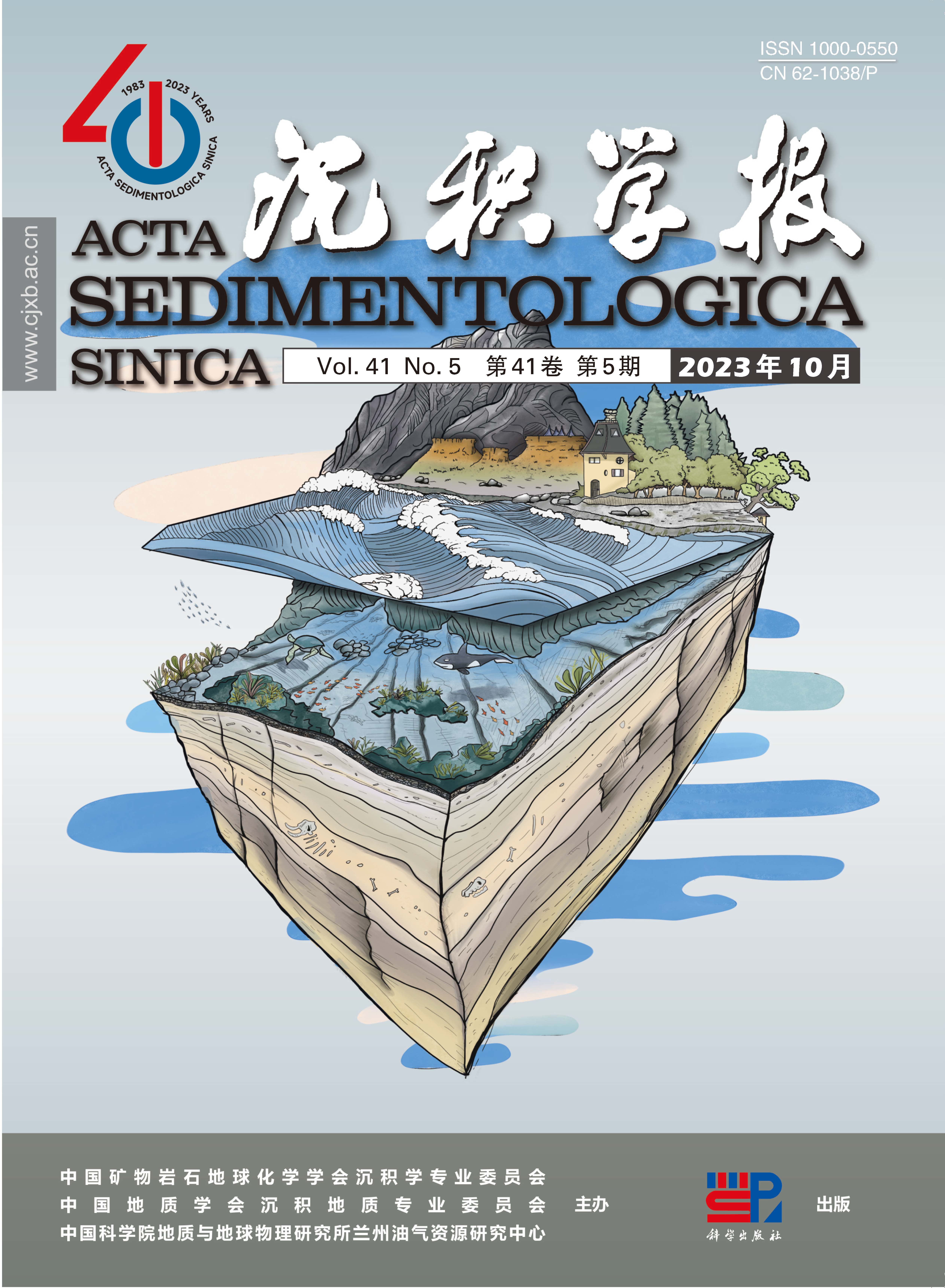


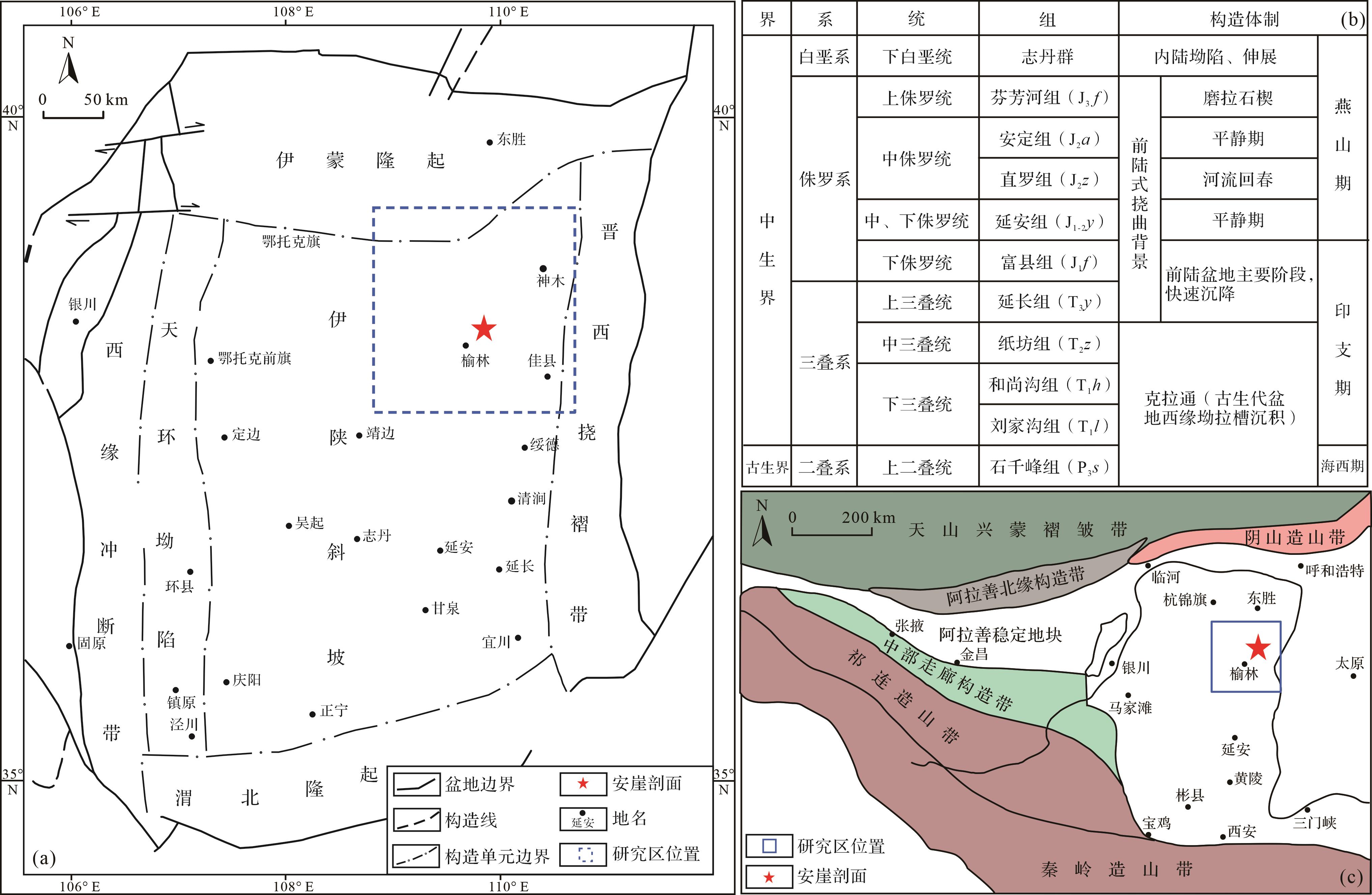





 DownLoad:
DownLoad:
